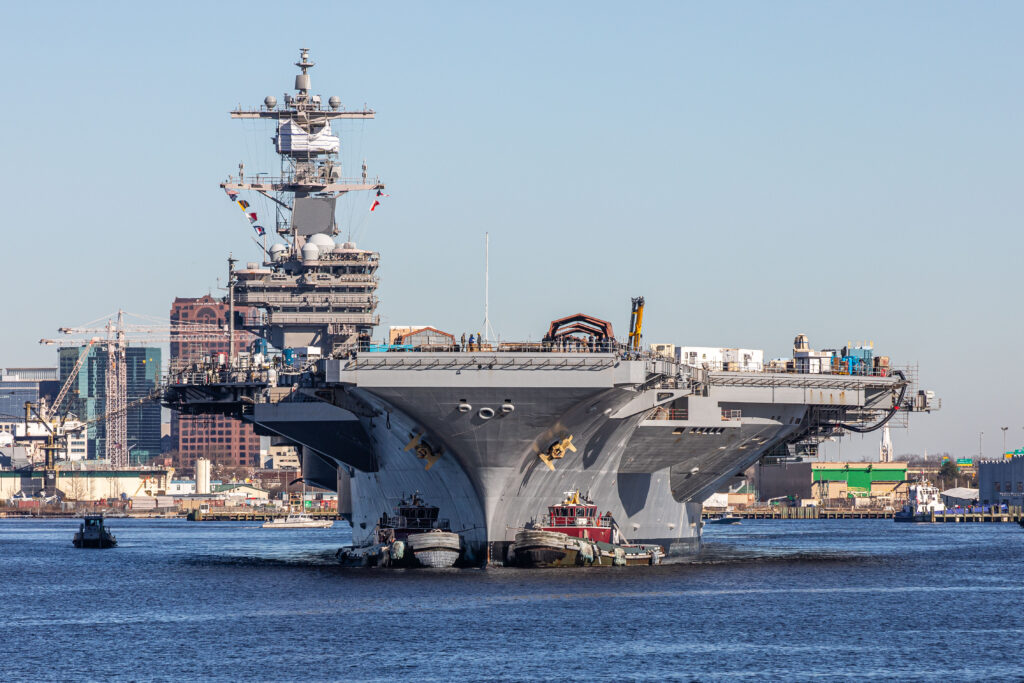
Delaying the next two-aircraft carrier buy beyond fiscal year 2028 would lead to sizable delays, growing cost and would have a serious impact on the shipbuilding industry and its supply base, according to a new report from the Aircraft Carrier Industrial Base Coalition (ACIBC).
“There are significant challenges that most of the companies in the supply base face,” ACIBC Chair Lisa Papini told Seapower, including “inflation, supply chain disruption and workforce issues.”
As was expressed last week by shipbuilder HII, the industry favors a “2-3-4” approach, with a two-carrier buy, three years of advance materials procurement and four years between carrier construction.
“Companies in the supply chain are planning work based on the stability of that schedule. When we maintain that schedule, that is when we are optimized and when we will perform at our best,” she said.
The ACIBC report notes that even a two-carrier buy in fiscal 28 means six years between the construction of CVN 81 and 82, and “nearly 50% of AP [advanced procurement] suppliers are already expected to have stopped continuous production [i.e., ‘go cold’] for their respective CVN material/equipment by then.”
Bumping the contracting for CVN 82 beyond fiscal 2028 would make things even worse, with 40% of carrier suppliers “saying they will need to lay off workers and/or deprioritize military shipbuilding and explore more commercial options,” the report says.
Papini said the delays and uncertainty are harmful to the industrial base, which is widespread ─ aircraft carriers are built and maintained with parts from more than 2,000 businesses in almost every state in the country.
A two-carrier buy means more lead time for raw material, which is now taking longer to procure than in the past, and also on the workforce itself, Papini said. “If we can place material on order earlier, that would help with the schedule.”
It would also help avoid “peaks and valleys” where shipbuilders become idle and are forced to lay off workers, which in turn makes the overall industry less attractive to workers.
“When that happens, we lose trained, highly qualified people,” she said. “And there’s a ramp-up period if we have to start up again. The workforce is at its best with steady, consistent funding and shipbuilding schedules.”
The decision on the buy for CVN 82 and 83 is expected to be in the next president’s budget, expected to be released soon. ACIBC is planning to conduct briefings on Capitol Hill in March with a second, more comprehensive report.
Papini said she welcomes the recent announcement from Secretary of the Navy Carlos Del Toro that he has ordered a comprehensive review of the Navy shipbuilding industry, with an interim progress review due in 45 days.
“He’s got a commitment in there that he is looking at recommended actions for achieving a healthy U.S. shipbuilding industrial base,” she said. “I think we’re talking about ways to achieve that, that’s hopefully what this survey is raising.”
The new study includes a look at three main major challenges to aircraft carrier suppliers, their impact and ways to resolve them, as drawn from a survey of suppliers across the country:
Inflation
- Challenge: 95% have faced challenges due to rising costs from inflation
- Impact: 79% have experienced raw material cost increases of at least 7%
- Resolution: 91% regard multi-ship “block buys” critical to offsetting inflation and contributing to the health and future of their company.
Supply Chain Disruptions
- Challenge: 91% have faced challenges as a result of material availability/delivery
- Impact: 76% have experienced an increase in the amount of time it takes to build and deliver their products
- Resolution: 64% regard earlier advanced funding critical to addressing increased material lead-times and meeting required in-yard dates.
Workforce Issues
- Challenge: 85% have faced challenges hiring, training, and retaining their workforce
- Impact: 32% believe workforce-related challenges have had a detrimental impact on their ability to fulfill contracts
- Resolution: 76% believe 3- or 4-year centers are optimal build intervals with 60% saying operating under four-year construction intervals will enable the hiring, retention and training of a workforce.






